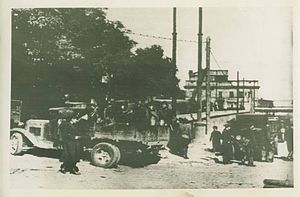
Back Обсада на Одеса Bulgarian Batalla d'Odessa Catalan Obležení Oděsy Czech Schlacht um Odessa German Πολιορκία της Οδησσού Greek Sieĝo de Odeso Esperanto Batalla de Odesa Spanish نبرد اودسا Persian Odessan taistelu Finnish Siège d'Odessa French
This article includes a list of general references, but it lacks sufficient corresponding inline citations. (June 2011) |
| Siege of Odessa | |||||||
|---|---|---|---|---|---|---|---|
| Part of the Eastern Front of World War II | |||||||
 Romanian troops in Odessa after the siege | |||||||
| |||||||
| Belligerents | |||||||
|
Aerial support: |
| ||||||
| Commanders and leaders | |||||||
|
|
| ||||||
| Units involved | |||||||
|
|
| ||||||
| Strength | |||||||
|
160,000 men (initially)[1] 340,223 men (total) |
34,500 men (initial)[2] 240 artillery pieces 86,000 men (total)[3] | ||||||
| Casualties and losses | |||||||
|
17,729 dead 63,345 wounded 11,471 missing 19 tanks 90 artillery pieces 20 aircraft[4] | 60,000 overall[5] | ||||||
The siege of Odessa, known to the Soviets as the defence of Odessa, lasted from 8 August until 16 October 1941, during the early phase of Operation Barbarossa, the Axis invasion of the Soviet Union during World War II.
Odessa was a port on the Black Sea in the Ukrainian SSR. On 22 June 1941, the Axis powers invaded the Soviet Union. In August, Odessa became a target of the Romanian 4th Army and elements of the German 11th Army. Due to the heavy resistance of the Soviet 9th Independent Army and the rapidly formed Separate Coastal Army, supported by the Black Sea Fleet, it took the Axis forces 73 days of siege and four assaults to take the city. Romanian forces suffered 93,000 casualties, against Red Army casualties estimated to be between 41,000 and 60,000.[5]
It is considered to be the "greatest independent success of the war by any minor Axis power".[6]
- ^ Axworthy (1995), p. 50.
- ^ Glantz (1995), p. 293
- ^ Одесская оборона 1941 — статья из Большой советской энциклопедии. Категория:Статьи с ссылкой на БСЭ, без указания издания
- ^ "The Battle of Odessa – 1941". WorldWar2.ro.
- ^ a b Axworthy, Mark. Third Axis Fourth Ally: Romanian Armed Forces in the European War, 1941–1945. p. 58.
- ^ Chan, Amy (8 February 2017). "Romanian Nightmare at Stalingrad". HistoryNet. Retrieved 28 February 2024.